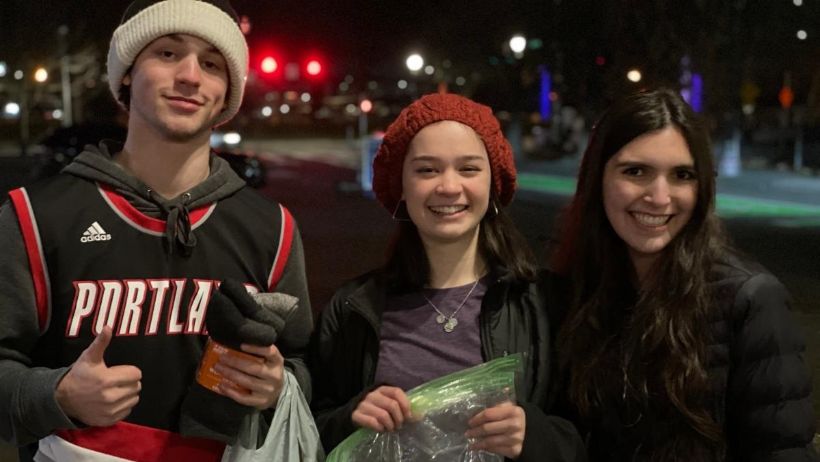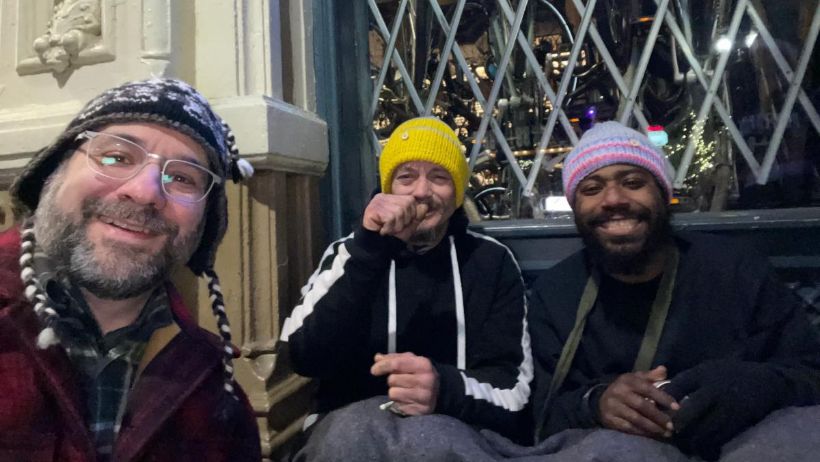Oasis Songs: Musings from Rav D
Friday, February 17, 2023 / 26 Shevat 5783
Summary: This week, I reflect on a “tzedakah field trip” my twelfth grade class and I took.
Reading Time: Four minutes
The rectangular, slim-profile mailing boxes had been sitting in my office for a few months, clamoring for attention while I waited for the weather to turn cold. Within them rested seventy or so cozy hats that were hand-knit by Martha Decherd’s sister-in-law. I had committed to distributing these to the heads of homeless Portlanders. With Mom’s death, the project was put on hold until this past Wednesday when my twelfth grade class and I drove down Naito.

No matter how many times we at CNS engage in this sort of direct connection with Portland’s unhoused, there are always surprises. The homeless can be likened to a river or to a mass of migratory birds. The river is always there, but its composition and shape are constantly shifting. During the raw heart of the pandemic, the city pretty much let our tent people be where they were, advised by the CDC that moving people might result in the spread of more disease. Thus was born the city’s Impact Reduction Program. It was, unsurprisingly, a failure.
The city’s own website, referencing the end of July 2020, remarked, “…if individuals remained non-compliant with public health directives, we posted a 24-hour warning notice to provide individuals living in encampments additional time to comply. Following the posted warning, if individuals are still non-compliant, we post our standard 48-hour notice for full property removal. The goal of these postings is to gain compliance with public health guidance and to get individuals to decompress their spaces. However, we have found that encampments return to a state of non-compliance within a matter of days, if not hours, depending on the location.” This despite the fact that the city was removing 650,000 pounds of garbage from these encampments each month.

As the tents proliferated, downtown businesses were harmed because foot traffic slowed; consumers were scared to walk among the litter or frequent establishments. Those dependent on accessibility devices were also hindered from navigating safely because of the quantity of trash.
Everybody was hurting—business owners, average citizens, and of course, the homeless themselves. Patience was wearing thin. In the intervening time, the city worked with non-profits to establish more formal “settlements” of both tents and tiny homes. Simultaneously, the sweeps restarted, particularly around holidays. Then, the police would endeavor to move the unhoused out of sight. But the scale of our housing problem dwarfs our best efforts and outpaces the resources that have been allocated to address this other pandemic, the crisis of homelessness that impacts so many of our national cities.
Like the myth of Sisyphus, who was condemned to roll an impossibly large boulder up a mountainside, only to have it careen downhill after all of his efforts, this tragedy continues its downhill trajectory. Humans can deal with almost any problem—so long as they can discern progress. When that seems missing, and solutions seem futile, despair, anger, and dehumanization inevitably arise.
After decades working periodically with the homeless, starting during my college days in New York, I have no better answers than the homeless advocates, the city’s politicians, or the outraged business owners who only want to contribute to Portland’s well-being while supporting their families. All are stymied because the systemic failures of a society that allows its citizens to end up living on the streets are far vaster than any municipality. There’s a moral sickness in our nation, everyone is touched by moral contagion, and the medicines we have don’t seem to be working.
What I do know is that moral problems require moral responses, and the first crucial element of this is to resist the forces of dehumanization so prevalent in today’s America. In a week when two Jews in Los Angeles were shot and antisemitism is on the rise, our unique historical context ought to remind us that Jews are not permitted to succumb to hatred or demonization, regardless of how unsavory we find a group, ideology, or movement. We need to always discern our common humanity, even among the most intolerant. One of the most potent methods to uncover our shared commonalities is to meet and connect with others.
With that in mind, our twelfth grade class’s goal was to reach out to the least desirable amid the ragged and filthy clusters of tents they call home, for these are the humans who are least likely to interact with agencies and institutions. Life circumstances have bruised them too much to trust. These are America’s towns of trauma. As one forty-year-old woman told us, “I have the deck stacked against me. I’m small, I’m female, and I am old.” When we asked her how long she had been on the streets, she replied, “Since I was 19.” Another man of similar age said that while living outdoors is cold, he’s been on the streets so long that being indoors now feels too hot. He’d like an apartment anyway, but doesn’t know how to make that happen, as his existence has been pared down to hand-to-mouth subsistence.
Despite those stories, one thing I noted was that the population of homeless with whom we interacted was younger than on previous outings. It’s hard to know what to make of this. Was this just the nature of the river on the night we went out? Did we hit an unrepresentative sample? Or has the pandemic killed off the older residents while forcing a new and younger population into their place? Although I peruse the literature on this, I don’t know.
What I do know is that we felt good distributing hats. We enjoyed meeting our unhoused neighbors. One of my twelfth graders wondered, “Why are people so scared of the homeless? They are just like us.” At the end of the night, we knew we made a difference. For one Wednesday, we refused to despair. That matters.
Shabbat shalom,
Rav D
Shabbat Table Talk
- Do you have any special skills, like knitting, wood working, or other crafts that you could use to bring some happiness to a marginalized community? Which community would you want to serve? Why?
- What volunteer work have you participated in that you found particularly meaningful? Did it stand out because of whom you were helping, what you were doing, or some other reason?
If you’d like to continue this discussion, follow this link to CNS’s Facebook page to share your own perspectives on the topics raised in this week’s Oasis Songs. Comments will be moderated as necessary.



